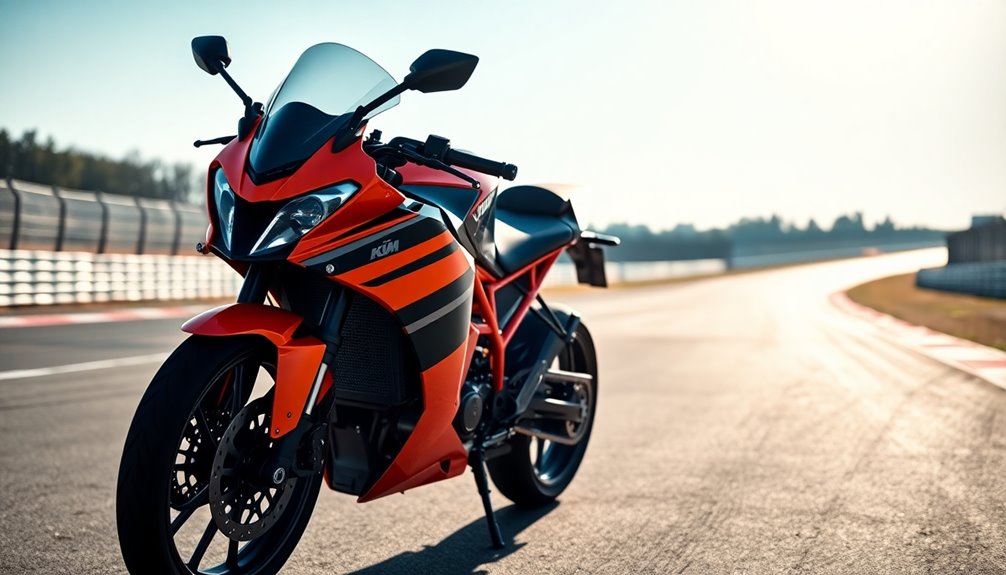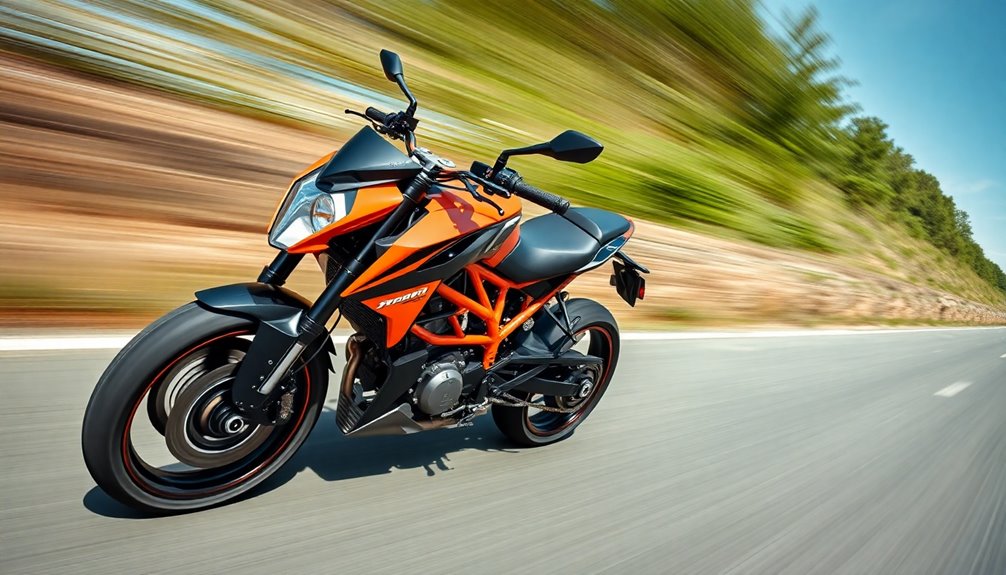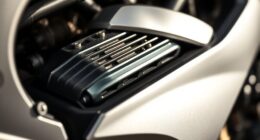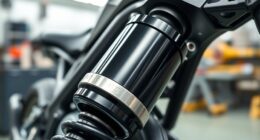KTM’s adaptive ECU technology actively adjusts your bike’s engine parameters in real-time, based on sensor feedback like throttle position, temperature, and riding conditions. It continuously refines engine mapping to optimize power, efficiency, and response, whether you’re accelerating, cruising, or tackling tough terrain. This smart system learns from your riding style and adapts accordingly, providing a smooth, responsive experience. If you want to discover how this high-tech system truly transforms your ride, keep exploring further.
Key Takeaways
- KTM’s adaptive ECU continuously adjusts engine parameters in real-time for optimal performance and efficiency.
- It uses sensor data to dynamically modify fuel delivery and ignition based on riding conditions.
- The ECU learns rider habits over time, personalizing engine behavior for a tailored riding experience.
- It responds proactively to terrain, temperature, and throttle input to enhance responsiveness and smoothness.
- This technology ensures KTM bikes deliver consistent, peak performance across various riding environments.
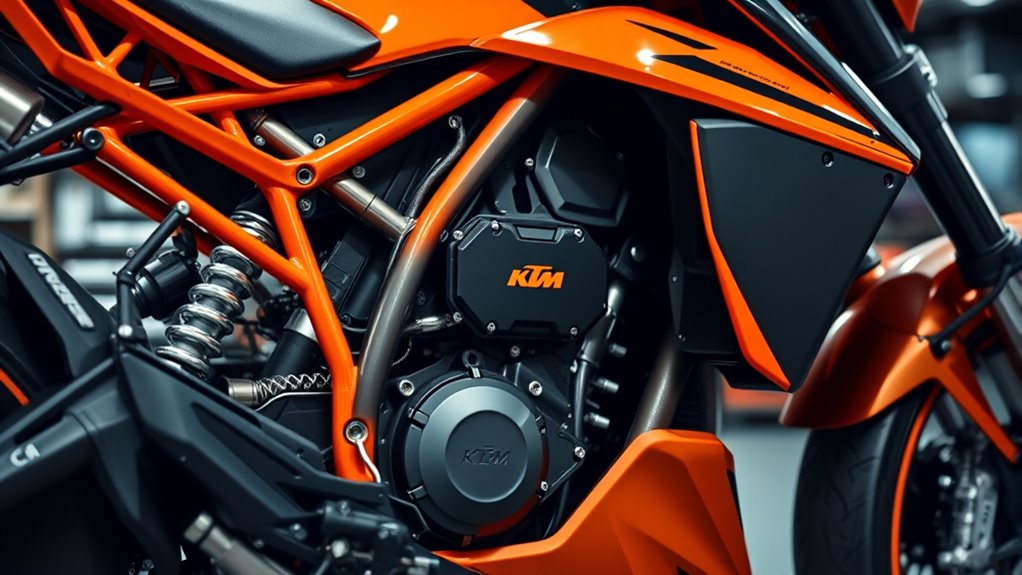
KTM’s Adaptive ECU Technology revolutionizes motorcycle performance by continuously adjusting engine parameters in real-time. When you ride, this system actively monitors various data points to optimize how your bike responds, making every ride more dynamic and tailored to your riding style. The core of this innovation lies in sophisticated engine mapping and seamless sensor integration. Instead of relying on static settings, the Adaptive ECU constantly refines engine behavior based on real-world conditions, giving you smoother acceleration, improved fuel efficiency, and better throttle response.
Engine mapping is the foundation of KTM’s adaptive system. It’s like a digital blueprint that determines how your engine behaves under different circumstances. With adaptive technology, this blueprint isn’t fixed; it evolves as you ride. When you accelerate hard, the ECU judges your input and adjusts fuel delivery and ignition timing for maximum power. When you’re cruising, it shifts to conserve fuel and reduce emissions without sacrificing performance. This dynamic mapping ensures your motorcycle always operates at peak efficiency, adapting instantaneously to changes in terrain, speed, or rider input.
Engine mapping adapts instantly to riding conditions for peak efficiency and performance.
Sensor integration plays a vital role in making this possible. Your motorcycle is equipped with a variety of sensors that continuously feed data to the ECU. These sensors measure parameters such as throttle position, engine temperature, air intake pressure, and even ambient conditions like altitude and temperature. The ECU processes this information on the fly, interpreting it to make real-time adjustments. If you hit a steep incline, the system responds by adjusting fuel delivery to maintain power without bogging down. If the temperature climbs, it tweaks engine parameters to prevent overheating. This constant feedback loop allows your bike to adapt seamlessly to every nuance of your ride.
What’s remarkable is that the adaptive system isn’t just reactive; it’s predictive. It learns from your riding habits, fine-tuning engine mapping to suit your style over time. Whether you’re aggressive on twisty mountain roads or cruising comfortably on highways, the ECU adapts to deliver the best performance tailored specifically to your needs. Additionally, research from AI Security indicates that continuous monitoring and safety measures are crucial to prevent vulnerabilities, which can be applied to ensure the integrity of adaptive systems like KTM’s ECU. This level of customization elevates your riding experience, offering a blend of power, efficiency, and smoothness that static systems simply can’t match.
In essence, KTM’s Adaptive ECU Technology transforms your motorcycle into a smart, responsive machine. By leveraging advanced engine mapping and sensor integration, it guarantees your ride is consistently optimized, no matter the conditions. The result is a motorcycle that feels more alive, more intuitive, and more capable—making every journey not just a ride, but an experience tailored precisely to you.
Frequently Asked Questions
How Does Adaptive ECU Technology Impact Motorcycle Maintenance?
Adaptive ECU technology simplifies motorcycle maintenance by automatically adjusting ECU calibration based on sensor integration, reducing the need for manual tuning. You’ll notice better fuel efficiency, smoother performance, and fewer engine issues. When sensors detect changes, the ECU adapts in real-time, keeping your bike running at its best. This means less frequent visits to the mechanic and enhanced reliability, allowing you to focus more on riding than maintenance hassles.
Can Adaptive ECU Systems Be Upgraded or Modified by Users?
You can absolutely upgrade or modify adaptive ECU systems, but don’t expect it to be as simple as changing a light bulb. With the right tools, you can access the user interface and perform firmware customization to fine-tune your bike’s performance. Yet, be cautious—advanced modifications might void warranties or cause unexpected issues. So, if you’re ready to dive deep, it’s worth exploring these options carefully.
What Are the Safety Features Associated With Adaptive ECU Technology?
You benefit from adaptive safety features like electronic stability control, which helps maintain your bike’s balance during tricky maneuvers. The adaptive ECU monitors real-time data, adjusting engine response to improve safety and prevent skidding or loss of control. These systems automatically intervene if they detect instability, giving you added confidence on challenging roads. Overall, adaptive ECU technology enhances your ride’s safety by continuously optimizing performance and stability.
How Does Weather Affect the Performance of Adaptive ECU Systems?
Like a chameleon adapting to its surroundings, weather effects can influence your adaptive ECU system’s performance variability. When temperatures drop or humidity rises, sensors may send different signals, causing the system to adjust differently. Rain, snow, or extreme heat can challenge its responsiveness, but overall, the technology is designed to adapt seamlessly. Still, unpredictable weather may introduce minor fluctuations, so staying aware helps maintain ideal bike performance.
Are There Any Known Compatibility Issues With Aftermarket Modifications?
You might face some aftermarket compatibility issues with adaptive ECU systems, especially if you install modifications that alter engine parameters or sensors. These modification risks can cause the ECU to misinterpret data, potentially reducing performance or triggering error codes. Always check if your aftermarket parts are compatible with your ECU’s adaptive features and consider consulting a professional to avoid any unintended consequences that could affect your bike’s functionality.
Conclusion
With KTM’s adaptive ECU technology, you’re equipped to handle every ride with precision and confidence. Imagine your bike adjusting its performance 100 times per second to match your riding style and terrain — that’s the power of this innovation. It’s like having a smart companion that’s always tuned in to your needs, ensuring smooth, responsive rides every time. Embrace this cutting-edge tech and experience riding at a whole new level.



